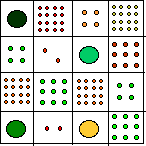Square foot gardening
Square foot gardening is the practice of dividing the growing area into small square sections, typically 1 foot (30 cm) on a side, hence the name. The aim is to assist the planning and creating of a small but intensively planted vegetable garden. It results in a simple and orderly gardening system, from which it draws much of its appeal. Mel Bartholomew coined the term "square foot gardening" in his 1981 book of the same name.
Overview

The phrase "square foot gardening" was popularized by Mel Bartholomew in a 1981 Rodale Press book and subsequent PBS television series. Bartholomew, a retired engineer, devised a raised 4 by 4 feet (1.2 m × 1.2 m) square beds with a grid. Each of these 4 by 4 square beds was then divided into sixteen one-foot squares, the grid. Each square is planted with a different crop species based on a formulation of either one, four, nine or sixteen plants per square depending on the plant's overall size. Once a “square foot” is harvested, a different crop can be planted for a continual harvest. To encourage a variety of different crops in succession, and to discourage pests, each square is used for a different kind of plant (crop rotation) within the growing season. The number of plants per square depends on an individual plant's size. For example, a single tomato plant takes a full square, as might herbs such as oregano, basil or mint, while lettuce plants would be planted four per square, and up to sixteen per square of plants such as radish or carrots. Tall plants are trellised on the north side of the bed to avoid shading smaller plants and prevent sprawling on the ground.
One advantage of densely planted crops is that they can form a living mulch and can also prevent weeds from establishing or even germinating. Also, natural insect repellent methods such as companion planting (e.g. planting marigolds or other naturally pest-repelling plants) become more efficient in a close space, which may reduce the need to use pesticides. The large variety of crops in a small space also prevents plant diseases from spreading easily[1]
Since the beds are typically small, making covers or cages to protect plants from pests, cold, wind or too much sun is more practical than with larger gardens. To extend the growing season of a square foot garden, a cold/hot frame may be built around it, and by facing the cold/hot frame south, the SFG captures more light and heat during the colder months of spring and winter.
In 2006 Bartholemew updated the concept with the book "All New Square Foot Gardening", which advocates using “Mel’s Mix” created by Bartholomew. After much experimentation, Bartholomew concluded that his formulation of 1/3 peat moss or coconut coir, 1/3 vermiculite and 1/3 blended compost yielded superior results in only a 6 inches (15 cm) depth. The benefits of the mix included keeping soil friable and virtually weed free with all the necessary nutrients. This mix eliminated the need for artificial fertilizer as compost is added each time you re-plant a square which provides enough nutrients naturally.
See also
- Companion planting
- French intensive gardening
- Organic gardening
- Raised bed gardening
References
- Pongsiri, Montira J.; Roman, Joe; Ezenwa, Vanessa O.; Goldberg, Tony L.; Koren, Hillel S.; Newbold, Stephen C.; Ostfeld, Richard S.; Pattanayak, Subhrendu K.; Salkeld, Daniel J. (2009). "Biodiversity loss affects global disease ecology" (PDF). BioScience. 59 (11): 945–954. doi:10.1525/bio.2009.59.11.6.
Further reading
- Bartholomew, Mel (2013). All New Square Foot Gardening (2nd ed.). Cool Springs Press. ISBN 978-1591865483. Retrieved Jan 30, 2015. ISBN 1591865484
- Ruppenthal, R J (2008). Fresh Food from Small Spaces: The Square-Inch Gardener's Guide to Year-Round Growing, Fermenting, and Sprouting. Chelsea Green Pub. Co. ISBN 9781603581455. Retrieved May 31, 2012. ISBN 9781603580281
- Bird, Christopher (2001). Cubed Foot Gardening: Growing Vegetables in Raised, Intensive Beds. Lyons Press. ISBN 9781599215914. Retrieved May 31, 2012. ISBN 1585743127
- Houbein, Lolo (2010). One Magic Square: The Easy, Organic Way to Grow Your Own Food on a 3-Foot Square. Experiment. ISBN 9781615191130. Retrieved May 31, 2012. ISBN 9781615190126
- (Fine Gardening) (2005). Gardening in Small Spaces. The Taunton Press, Inc. ISBN 9781561585809. Retrieved May 31, 2012.
- Bowman, Daria Price; Price, C A (2009). The Complete Idiot's Guide to Vegetable Gardening. Alpha. ISBN 9781101022139. Retrieved May 31, 2012. ISBN 9781592579075
External links
| Wikimedia Commons has media related to Square foot gardening. |
